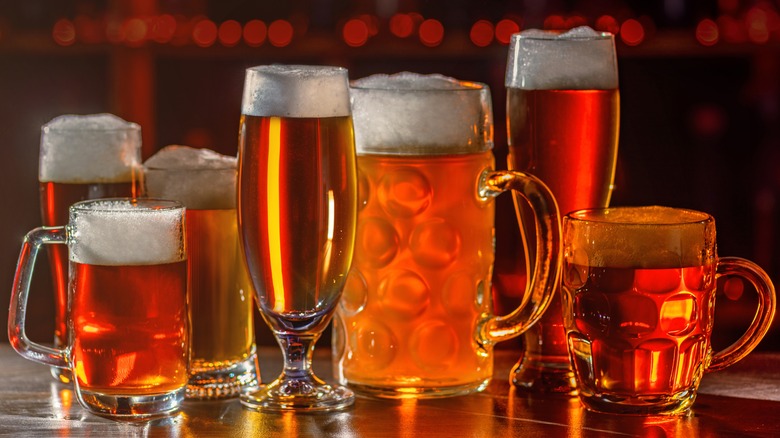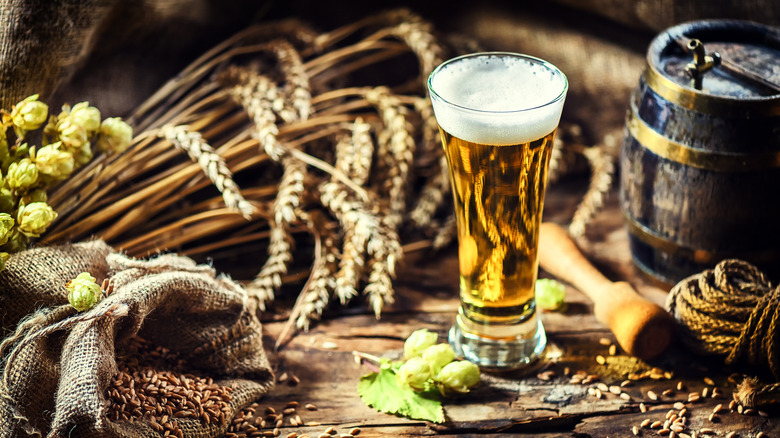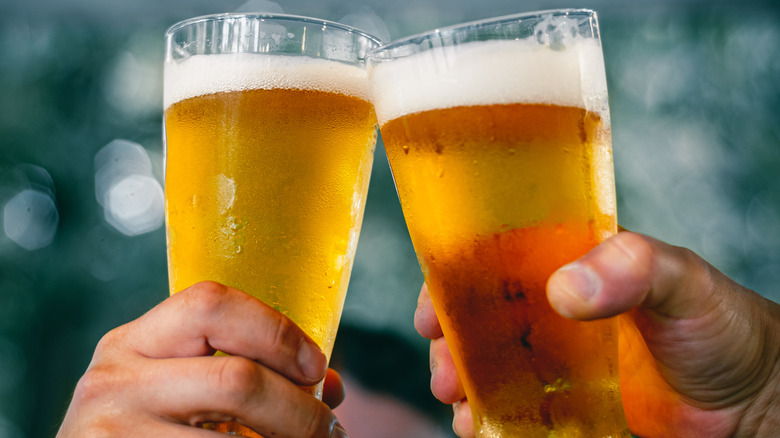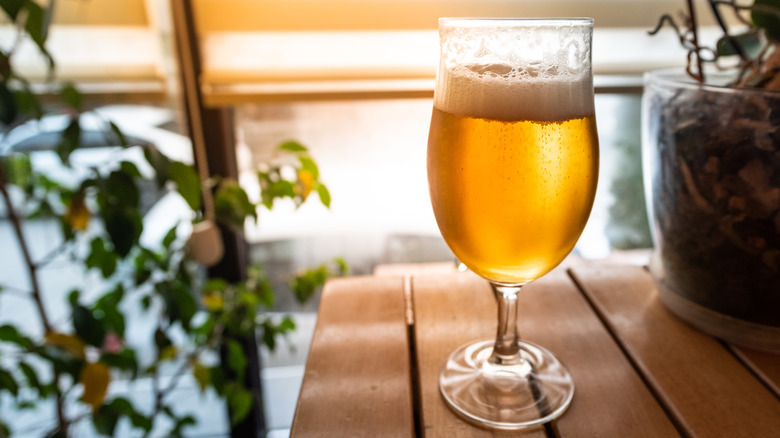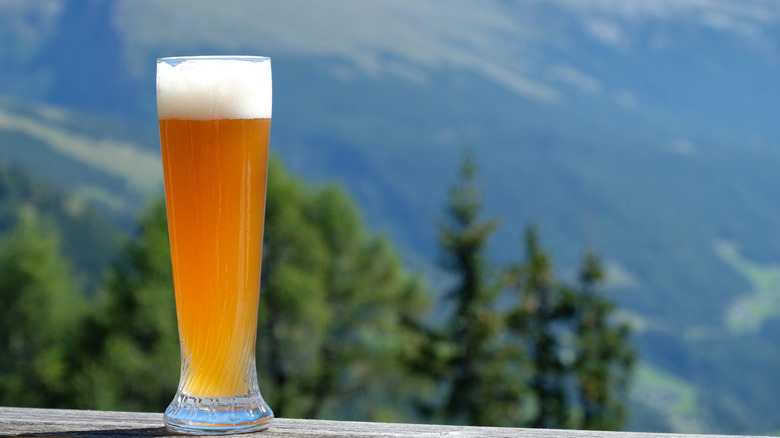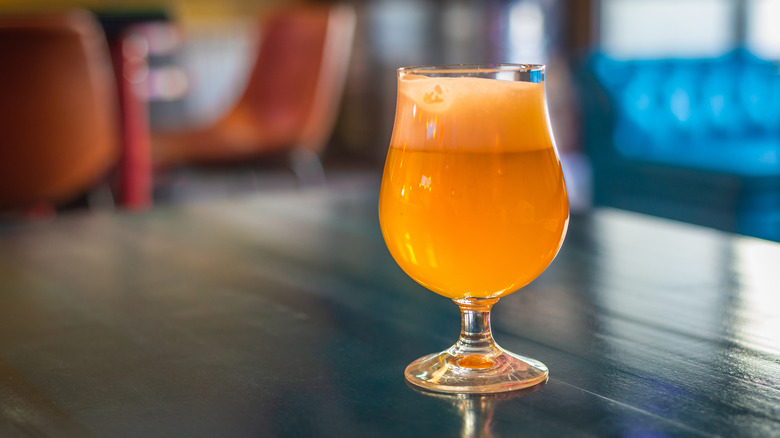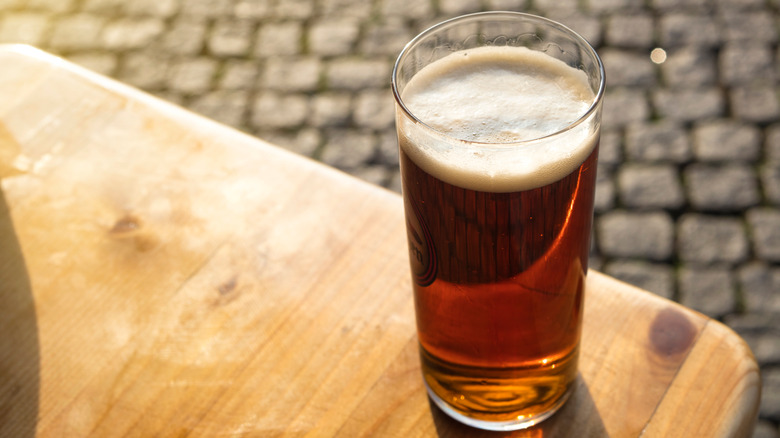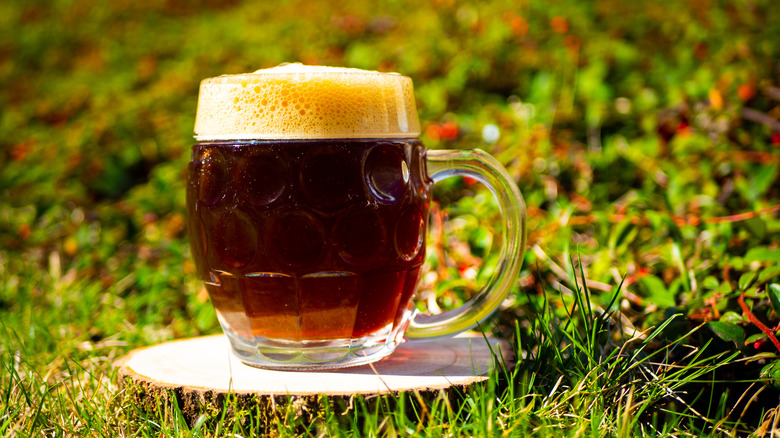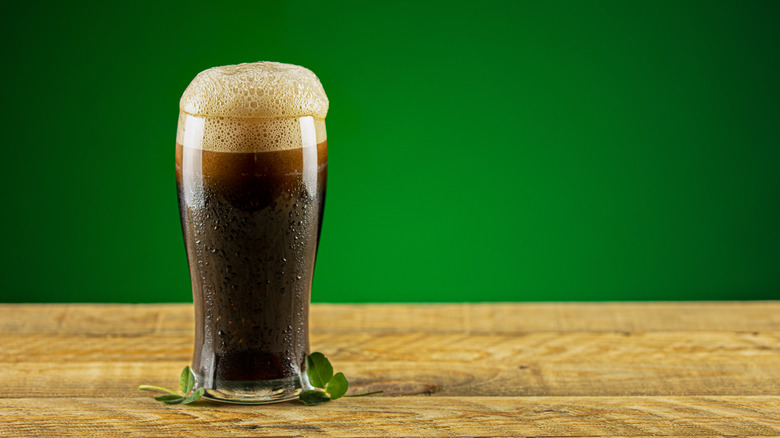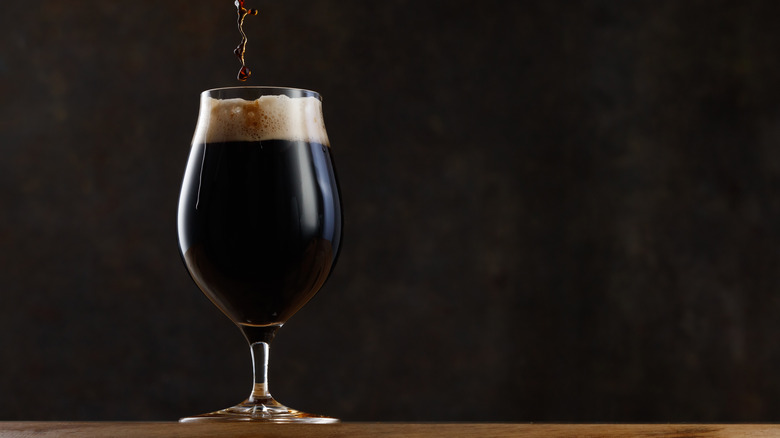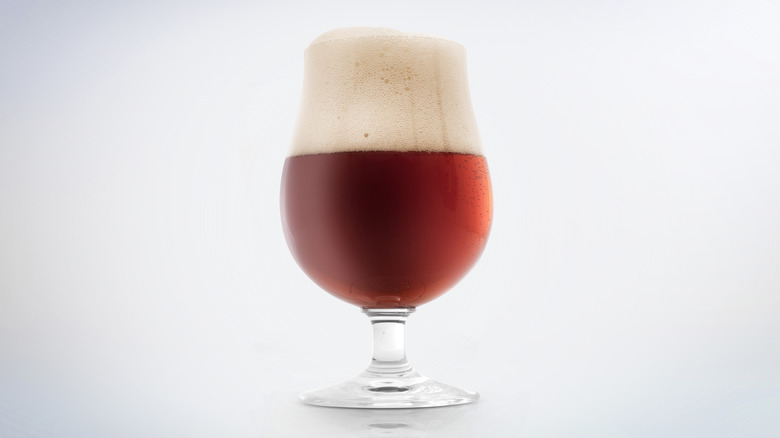Get To Know These German Beer Styles For Oktoberfest 2022
This time every year, you'll notice liquor stores stock their shelves high with Oktoberfest beers from breweries all over the country and across the globe. The very first Oktoberfest was held in Munich on October 12, 1810, to celebrate the marriage between the Crown Prince of Bavaria, later King Louis I, and Princess Therese von Sachsen-Hildburghausen. German citizens were all invited, and the festival lasted two weeks (per Britannica). The Oktoberfest in Munich now draws millions of visitors every year, and similar celebrations are held all across the United States in predominately German-American cities.
Oktoberfest beer, or Märzen lager, is the unofficial beverage of this annual festival because of its association with the changing of seasons. The Märzen, or "March," drink was originally brewed in spring to be stored in cold caves for the summer. Once the weather became cooler and more beer-friendly, it was retrieved to be enjoyed throughout the fall and winter (per American Craft Beer).
The Märzen lager is obviously the beer of choice to celebrate Oktoberfest, but for those not keen on it, there are dozens of other German alternatives to try. You are guaranteed to find at least one you like, so you'll be able to get into the Oktoberfest spirit with your stein full. Tasting Table spoke with Jack van Paepeghem, Quality Manager at von Trapp Brewing in Stowe, Vermont, to learn the basics of German beer and its many styles. Prost!
German pils
According to van Paepegham, German pils is the most popular beer on this list. It was actually first brewed because of the massive popularity of the Czech pilsner, first brewed in 1842 (per van Paepeghem). The Czech pilsner is called such since it was made in Plzen, a city in the Czech Republic. However, the German variety is referred to as a "pils." This abbreviation is not the only difference between the two beers, though.
German pils is brewed using German-grown pilsner malt, noble-type hops (think old-school) from the Hallertau and Tettnag region, and lager yeast. These ingredients produce a drier beer with a light body and malt character. This emphasizes its floral hops for a super refreshing, sharp finish. There are even two types of German pils: Northern German pils is more about the hops' bitterness, as opposed to a Bavarian pils, which is keener on the hops' aromatics and, therefore, has a smoother finish.
No matter which type of German pils you find yourself sipping on, they are each their totally own thing. Meanwhile, Czech pilsners carry a fuller body that is darker and has a more malty character. While all pilsners can be easily drinkable, thirst-quenching beers, the German pils' crispness is what makes them stand out. German pils typically contain an ABV between 4.8% and 5.2%.
Helles
While the pils is the most popular beverage around this time of year, van Paepeghem believes the helles lager is the best introduction to German beer for newcomers. He compares helles lagers to mainstream, macro-produced American lagers like Budweiser or Coors. The word "helles" translates to "bright" or "pale" in German as a reference to the drink's light, golden color and drinkability. It is the most common style of beer found in Munich, a testament to its seemingly universal appeal.
Essentially, a helles is an even lighter version of the German pils. It is made using the same malts, hops, and type of yeast. The only difference is the presence of hops on the palate: While a German pils, no matter the region it comes from, carries at least a slight bite, a helles does not place much emphasis here. This lager is definitely aromatic in its hops. However, its flavor profile is wonderfully balanced, sweeter, and welcoming. Also, because the character of a helles depends more on technique, the final ABV range is wider than a pils. The alcohol content of helles lagers can fall between 4.7% and 5.4%.
Kölsch
The Kölsch is not only a very popular German beer; it's a beer style you will most likely find at your local craft brewery all year long. It is basically a cross between an ale and a lager. It is made with the same malts and hops as a German pils or helles, but uses ale instead of lager yeasts and is brewed at cooler temperatures for an extended period before clarification (via van Paepeghem).
The Kölsch originally comes from the city of Cologne. According to van Paepeghem, in 1986, local brewers actually established the Kölsch Convention to solidify the qualifications required for a beverage to be classified as a Kölsch beer. They generally contain an average amount of alcohol, typically between 4.4% and 5.2%.
Ales are normally made at higher temperatures, so this blend of brewing methods results in a unique beer that's really one of a kind. It's light, dry, and mild in malt, but it also carries subtleties of spicy hops and notes of fruity flavors. The Kölsch is approachable to any beer drinker and definitely worth a try.
Hefeweizen
You've probably encountered a beer labeled as a "Weissbier." According to van Paepeghem, this is an umbrella term: "Weissbier" refers to any beer made with wheat. There are many styles of this beverage, including dunkelweiss, weizenbock, kristalweiss, and, the most popular, hefeweizen.
Hefeweizen is a relatively modern type of German beer. Although wheat has been used for brewing the drink for centuries, weissbiers were typically reserved for Bavarian royalty. In the middle of the 20th century, hefeweizens became widely available in Germany and beyond (per van Paepeghem). These beers are made with 50% wheat and 50% pilsner malt. They are brewed with low amounts of hops and then fermented warm with weizen yeast before being keg-conditioned. This means that the beer is re-fermented and naturally accumulates its carbonation, as opposed to the usual method of forcing carbonation into it.
Hefeweizens are a super drinkable, soft beverage with a mild malt and creamy taste. The light, floral hops balance the malt with a subtle sweetness carried by the fruity yeast aromas. Because of the keg conditioning, these beers are highly carbonated, which means they are highly refreshing. Hefeweizens are hazy and pale in appearance and normally contain an ABV between 4.3% and 5.6%.
Gose
Just like how all hefeweizens are weissbiers, but not all weissbiers are hefeweizens, all goses are sours, but not all sours are goses. Gose dates back to the 18th century and is associated with the cities of Goslar and Leipzig (per van Paepeghem). It is made with pilsner and wheat malts, low hops, coriander, and salt. This is what separates a gose from a regular sour: the salinity. It is traditionally fermented with a blend of ale yeast and lactobacillus bacteria to produce low amounts of lactic acid, the typical method for all sour ales.
As mentioned previously, the salt in gose is what makes this beer style its own thing. The salinity provides a distinct tartness not normally found in a sour. Goses carry a mild malt character as well as bright and tangy lemon balanced out by the floral notes of the coriander. The drink is quenching and may be unlike anything you've had before. If you like sour beers, you have to try a gose. And if you've never had a sour beer, a well-made gose is the perfect introduction.
Altbier
The altbier is the first — and only — beer style on this list to come out of Dusseldorf. According to van Paepeghem, the drink was first brewed in the late 1800s in the old-style or "alt" style of German brewing, which used ale yeasts and lager techniques, similar to a Kölsch. Altbiers are made using pilsner and Munich malts, plus a small amount of roasted malts, which gives the drink its darker color. Noble hops (usually spalt) are incorporated before the beer is cold-fermented and cold-conditioned.
The altbier is a light to medium-bodied beverage with the familiar crispness of pilsner and Munich malts, but with the added toastiness and caramel flavor of roasted malts. The clear amber color makes for an enticing appearance, and the peppery hops lead the way to a dry finish. A darker beer like an altbier may not taste the way it looks; other dark beers like an amber ale typically have maltier, elongated finishes, but the altbier gives you all the nuttiness you'd like with that same sharp flavor.
Rauchbier
The term "rauchbier," like weissbier, refers to a larger category of lagers, this one consisting of those that utilize a smoked malt, according to van Paepeghem. Traditionally, beechwood is used for this purpose, which is dried over open, wood-fed fires to impart smoky aromatics into the grains. This method is still used in some local German breweries today, but most makers of rauchbiers now utilize cleaner, indirect kilning methods.
Rauchbiers contain small amounts of German noble hops and other smoked malts and can use oak or other fruit wood. These beers appear dark amber or even brown, and their color is a good indication of their taste. A rauchbier's taste can vary based on the brewer, so smokiness can range between subtle and intense. However, the sweetness is generally on the lower side, and the hop bitterness and aroma quietly arrive at the finish.
Rauchbiers are actually the personal favorite German beer of van Paepeghem, which means they are definitely worth a try. They can range anywhere between 4.8% and 6.5% ABV.
Dunkel
According to van Paepeghem, the dunkel is the unsung hero of this list. He believes this beer does not quite get the recognition it deserves, and more people should be giving it a shot. The dunkel is Munich's original dark lager and dates back to the 15th century. It was included in the 1516 Reinheitsgebot, or German Beer Purity Law, which dictated that beer can only be produced using water, barley, hops, and yeast and cannot include any flavor additives (Ohio State University).
Dunkel lagers are a direct product of Munich. They use the city's city water and malt as well as other roasted malts, noble hops, and lager yeast. A dunkel is also made using a decoction mash, where a portion of the grain is removed, boiled, and added back to the mash to increase its resting temperature before fermentation.
The roasted malt of dunkel lagers is definitely at the forefront of their flavor profile. They are rich, toasty, and have notes of caramel and chocolate. The reduced hops bitterness results in a subtle sweetness with earthy aromas and a crisp and clean finish. Dunkel lagers appear dark copper or russet brown and normally contain an ABV from 4.5% to 5.6%.
Schwarzbiers
Schwarzbiers are another dark beer but are not as malty or rich as bocks or doppelbocks. Commonly referred to as a "black pilsner," schwarzbiers are also made with Munich, pilsner, and roasted malts but contain a bigger hops character. The German noble hops provide more aroma and bitterness, contributing to the familiar dry and crisp finish we all like in pilsners.
However, flavor-wise, schwarzbiers really provide the best of both worlds. Notes of dark chocolate and coffee from the roasted malt, combined with the earthy hops aromas and bitterness, make for a smooth, complex profile that is not overly robust in any department. Schwarzbiers are wonderfully balanced, unique lagers that carry a dark brown or light black color that almost tricks you once you have a clean, first sip. Despite the color, the drink carries a lighter body and an effortless finish. The ABV of schwarzbiers typically falls between 4.4% and 5.4%.
Bock
Bock beers are stronger lagers that originated in the northern German city of Einbeck. In accordance with another brewing law, bocks must have a starting gravity above 16 degrees Plato. According to van Paepeghem, "starting gravity" refers to the target amount of sugars from beginning to end. The more sugars there are to be fermented, the more alcohol will turn out as a result. This higher starting gravity translates to bock's ABV falling anywhere between 6.3% to 7.2%.
Besides this higher sugar-alcohol content, bocks are made with either Munich or Vienna-based malts and a small number of roasted malts for coloring. They are accompanied by light hoppiness and low bitterness from noble hops and lager yeast. This results in a malt-forward lager with almost a toffee sweetness. Bocks are full-bodied and easy in the higher alcohol content to bring a certain warmth and comfort we love in dark beers. These favorable characteristics are taken to another level with the next brewed beverage on this list.
Doppelbock
Although doppelbocks did not originate in Einbeck, they carry similar but intensified characteristics as the regular bock. Pilsner and Munich malts are utilized with other roasted malts for color and flavor. Like bocks, doppelbocks have a low bitterness from noble hops and use lager yeast. Per van Paepeghem, the first doppelbocks were originally referred to as "liquid bread" because of their full body and rich, sweeter malt taste.
These lagers have slight notes of caramel, toffee, chocolate, and dark fruit. The lower amount of hops contributes more of a spicy aroma than flavor. Doppelbocks are rich, complex, and ever-enticing with their dark ruby color. Just like regular bock beers, the higher alcohol content of doppelbocks is disguised behind the rich malt and full body. The ABV can fall anywhere between 7% and 10%.
If you enjoy bocks or doppelbocks — or give them a try and find that you do — be on the lookout for a new beer by Von Trapp Brewing releasing in October. It's called a Trostem, and it's a smoked winter lager with an ABV of 6%. Van Paepeghem says the Trostem falls between a bock and doppelbock, so if you think you'd like either, this new beer is a must-try.
